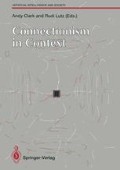Abstract
Connectionism and computationalism are currently vying for hegemony in cognitive modelling. At first glance the opposition seems incoherent, because connectionism is itself computational, but the form of computationalism that has been the prime candidate for encoding the “language of thought” has been symbolic computationalism (Dietrich 1990; Fodor 1975; Hamad 1990c; Newell 1980; Pylyshyn 1984), whereas connectionism is non-symbolic (Fodor and Pylyshyn 1988 — or, as some have hopefully dubbed it, “subsymbolic” — Smolensky 1988). This chapter will examine what is and is not a symbol system. A hybrid non-symbolic/symbolic system will be sketched in which the meanings of the symbols are grounded bottom-up in the system’s capacity to discriminate and identify the objects they refer to. Neural nets are one possible mechanism for learning the invariants in the analogue sensory projection on which successful categorization is based. “Categorical perception” (Hamad 1987a), in which similarity space is “warped” in the service of categorization, turns out to be exhibited by both people and nets, and may mediate the constraints exerted by the analogue world of objects on the formal world of symbols.
Access this chapter
Tax calculation will be finalised at checkout
Purchases are for personal use only
Preview
Unable to display preview. Download preview PDF.
References
Berlin B, Kay P (1969) Basic color terms: their universality and evolution. University of California Press, Berkeley
Boynton RM (1979) Human color vision. Holt, Rinehart and Winston, New York
Cottrell G, Munro P, Zipser D (1987) Image compression by back propagation: an example of extensional programming. ICS Report 8702, Institute for Cognitive Science, UCSD
Davis M (1958) Computability and unsolvability. McGraw-Hill, Manchester
Dietrich E (1990) Computationalism. Social Epistemol 4: 135–154
Elman J, Zipser D (1987) Learning the hidden structure of speech. ICS Report 8701, Institute for Cognitive Science, UCSD
Fodor JA (1975) The language of thought. Crowell, New York
Fodor JA (1985) Pfecis of “The modularity of mind”. Behav Brain Sci 8: 1–42
Fodor J, Pylyshyn Z (1988) Connectionism and cognitive architecture: a critical analysis. Cognition 28: 3–71
Gibson EJ (1969) Principles of perceptual learning and development. Prentice Hall, Englewood Cliffs, NJ
Grossberg SG (1984) Some physiological and pharmacological correlates of a developmental, cognitive, and motivational theory. In: Karrer R, Cohen J, Tueting P (eds) Brain and information: event-related potentials. Ann NY Acad Sci 425: 58–151
Hanson S, Burr D (1990) What connectionist models learn: learning and representation in connectionist networks. Behav Brain Sci 13: 471–518
Harnad S (1984) Verifying machines’ minds. Contemp Psychol 29: 389–391
Harnad S (ed) (1987a) Categorical perception: the groundwork of cognition. Cambridge University Press
Harnad S (1987b) Category induction and representation. In: Harnad S (ed) Categorical perception: the groundwork of cognition. Cambridge University Press
Harnad S (1987c) Uncomplemented categories, or, what is it like to be a bachelor. Presidential address, 13th Annual Meeting of the Society for Philosophy and Psychology, UCSD
Harnad S (1989) Minds, machines and Searle. J Exp Theor Artif Intell 1: 5–25
Harnad S (1990a) The symbol grounding problem. Physica D 42: 335–346
Harnad S (1990b) Lost in the hermeneutic hall of mirrors. J Exp Theor Artif Intell 2: 321–327
Harnad S (1990c) Commentary on Dietrich’s (1990) “Computationalism”. Social Epistemol 4: 167–172
Harnad S (1990d) Symbols and nets: cooperation vs. competition. Review of: Pinker S, Mehler J (eds) (1988) Connections and symbols. Connection Sci 2: 257–260
Harnad S (1991) Other bodies, other minds: a machine reincarnation of an old philosophical problem. Minds Machines 1: 93–54.
Harnad S, Hanson SJ, Lubin J (1991) Categorical perception and the evolution of supervised learning in neural nets. In: Powers DM, Reeker L (eds) Machine Learning of Natural Language and Ontology (Symposium on Symbol Grounding: Problem and Practice). Working Papers of the American Association for Artificial Intelligence, Spring Symposium, Stanford University, March 1991; reprinted in Deutsches Forschungzentrum fuer Kuenstliche Intelligent Document D-91-09:65-74.
Kleene SC (1969) Formalized recursive functionals, and formalized realizability. Providence, American Mathematical Society
Lane H (1965) The motor theory of speech perception: a critical review. Psychol Rev 72: 275–309
Lawrence DH (1950) Acquired distinctiveness of cues: II. Selective association in a constant stimulus situation. J Exp Psychol 40: 175–188
Lucas J (1961) Minds, machines and Gödel. Philosophy 36: 112–117
McClelland JL, Rumelhart DE, PDP Research Group (1986) Parallel distributed processing: explorations in the microstructure of cognition, Vol 1. MIT/Bradford, Cambridge, MA
Miller GA (1956) The magical number seven, plus or minus two: some limits on our capacity for processing information. Psychol Rev 63: 81–97
Minsky M, Papert S (1969) Perceptrons: an introduction to computational geometry. MIT Press, Cambridge, MA
Newell A (1980) Physical symbol systems. Cognitive Sci 4: 135–183
Penrose R (1989) The emperor’s new mind. Oxford University Press
Penrose R (1990) Précis of: “The emperor’s new mind”. Behav Brain Sci 13: 643–705.
Pylyshyn ZW (1984) Computation and cognition. Bradford Books, Cambridge, MA
Searle JR (1980a) Minds, brains and programs. Behav Brain Sci 3: 417–424
Searle JR (1980b) Intrinsic intentionality. Behav Brain Sci 3: 450–457
Shepard RN, Cooper LA (1982) Mental images and their transformations. MIT Press/Bradford, Cambridge, MA
Siegel JA, Siegel W (1977) Absolute identification of notes and intervals by musicians. Perception Psychophysics 21: 143–152
Smolensky P (1988) On the proper treatment of connectionism. Behav Brain Sci 11: 1–74
Turing AM (1964) Computing machinery and intelligence. In: Anderson A (ed) Minds and machines. Prentice Hall, Englewood Cliffs, NJ
Tversky A (1977) Features of similarity. Psychol Rev 84: 327–352
Ullman S (1980) Against direct perception. Behav Brain Sci 3: 373–415
Wittgenstein L (1953) Philosophical investigations. Macmillan, New York
Zadeh LA (1965) Fuzzy sets. Information Control 8: 338–353
Editor information
Editors and Affiliations
Rights and permissions
Copyright information
© 1992 Springer-Verlag London Limited
About this chapter
Cite this chapter
Harnad, S. (1992). Connecting Object to Symbol in Modelling Cognition. In: Clark, A., Lutz, R. (eds) Connectionism in Context. Artificial Intelligence and Society. Springer, London. https://doi.org/10.1007/978-1-4471-1923-4_5
Download citation
DOI: https://doi.org/10.1007/978-1-4471-1923-4_5
Publisher Name: Springer, London
Print ISBN: 978-3-540-19716-4
Online ISBN: 978-1-4471-1923-4
eBook Packages: Springer Book Archive

